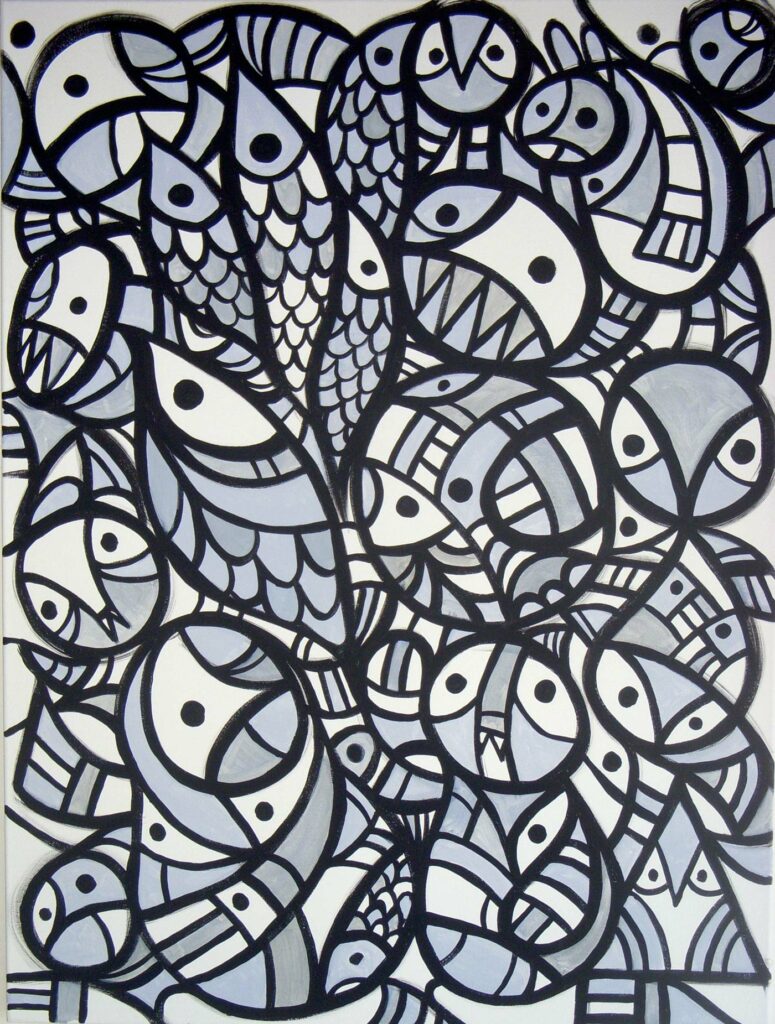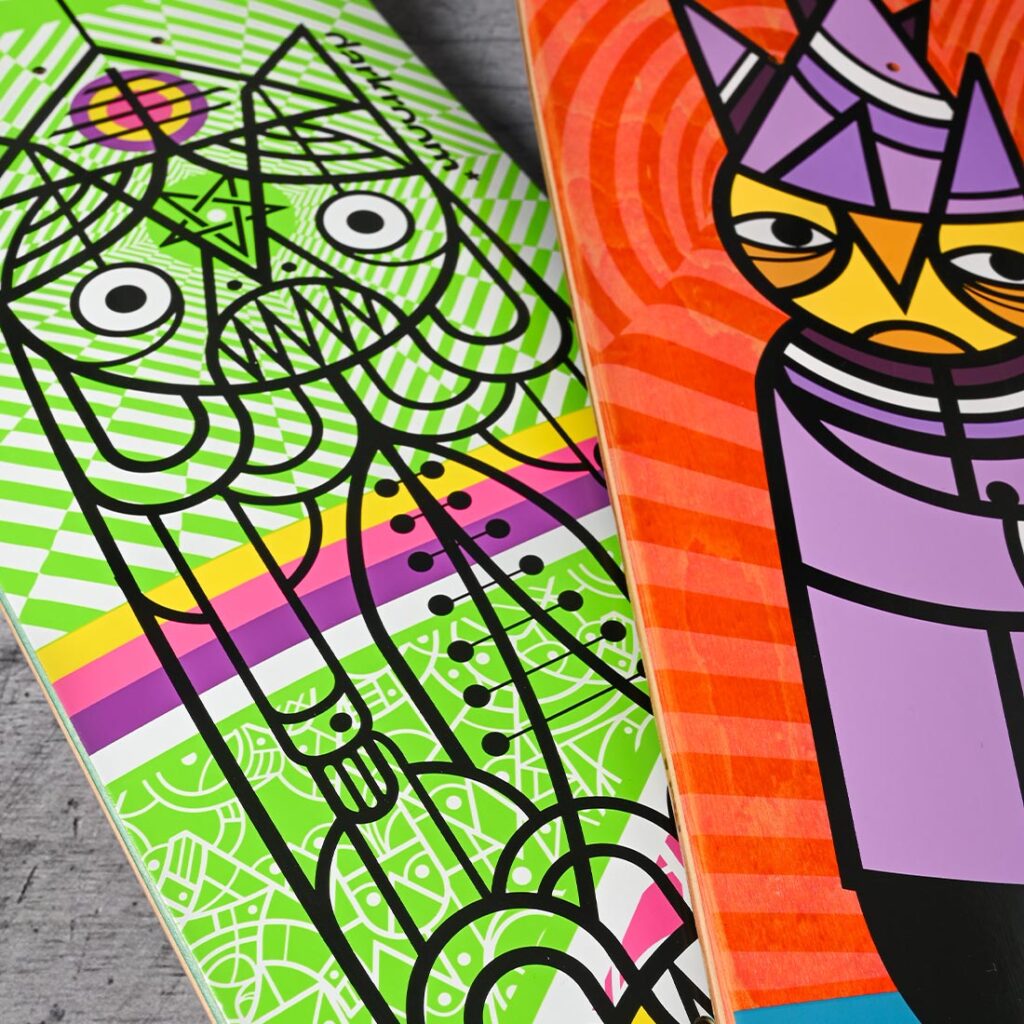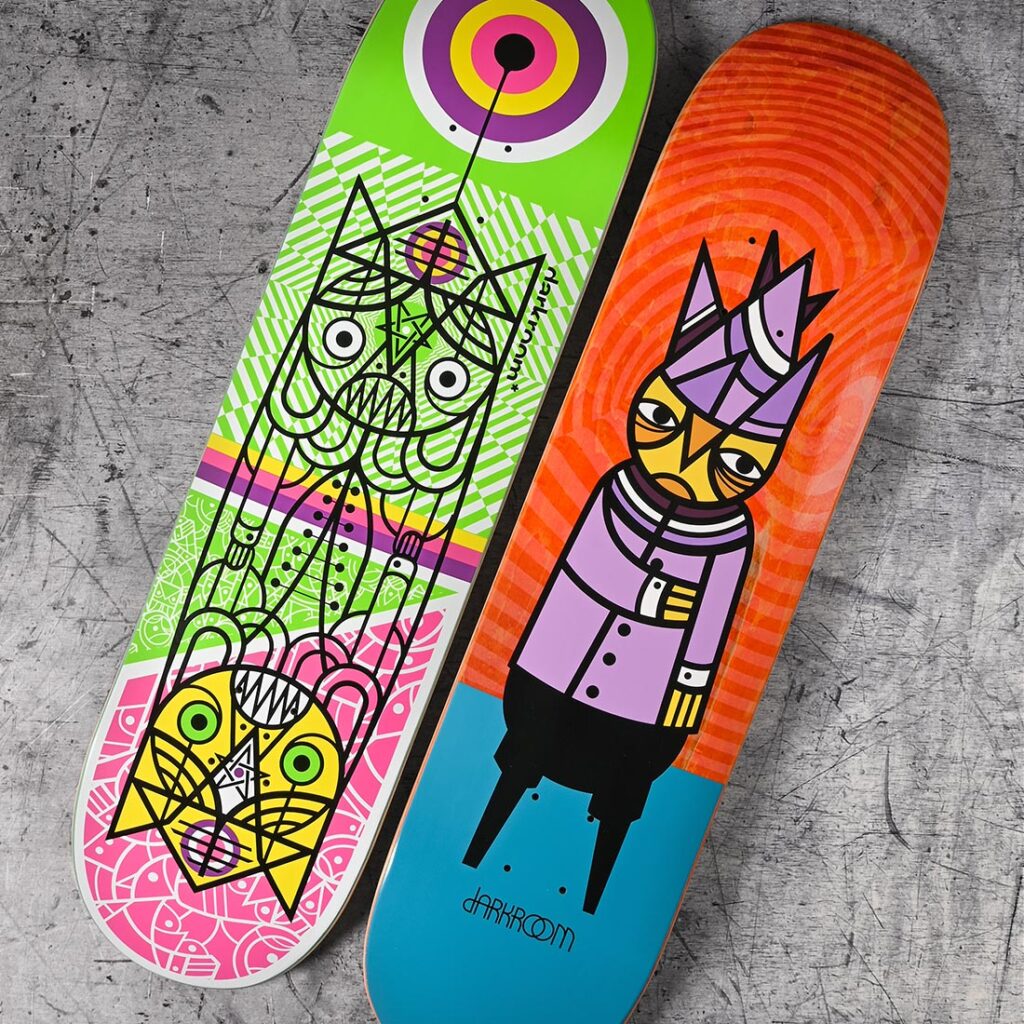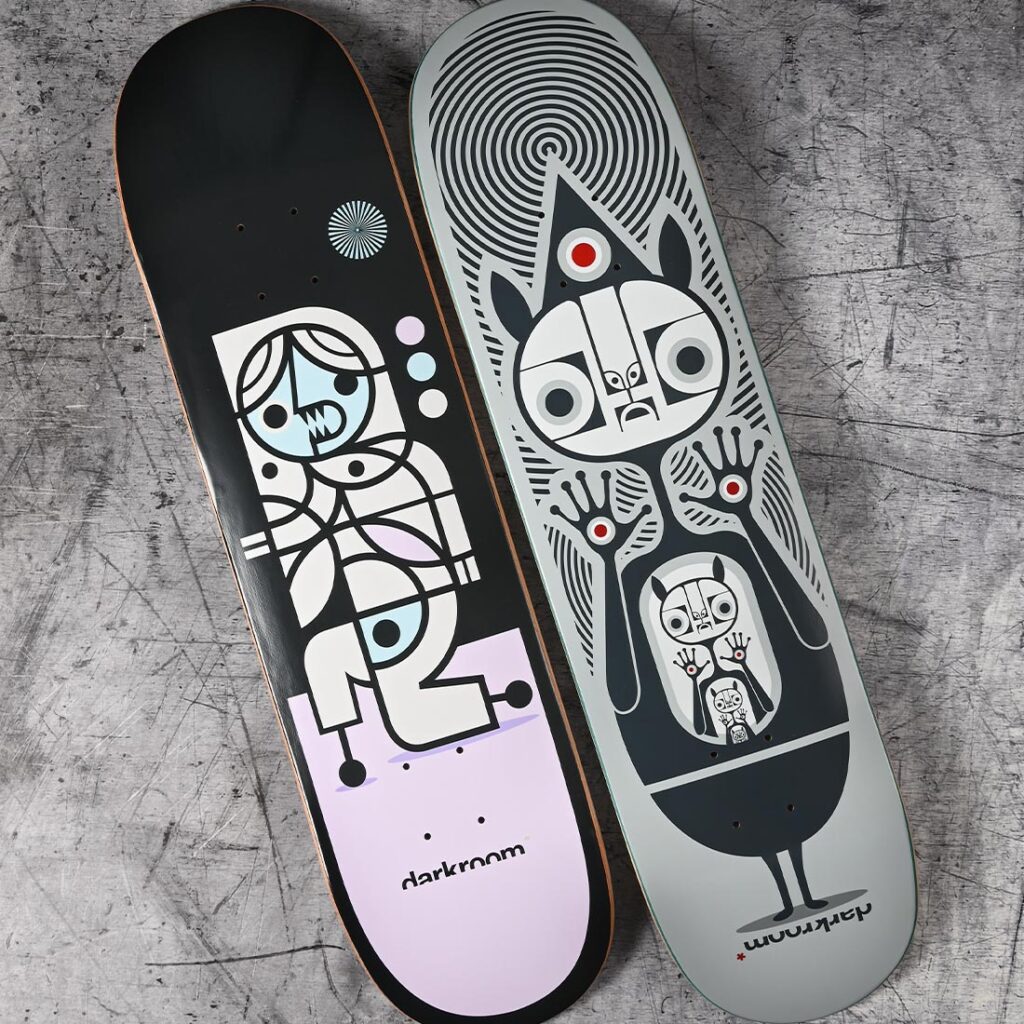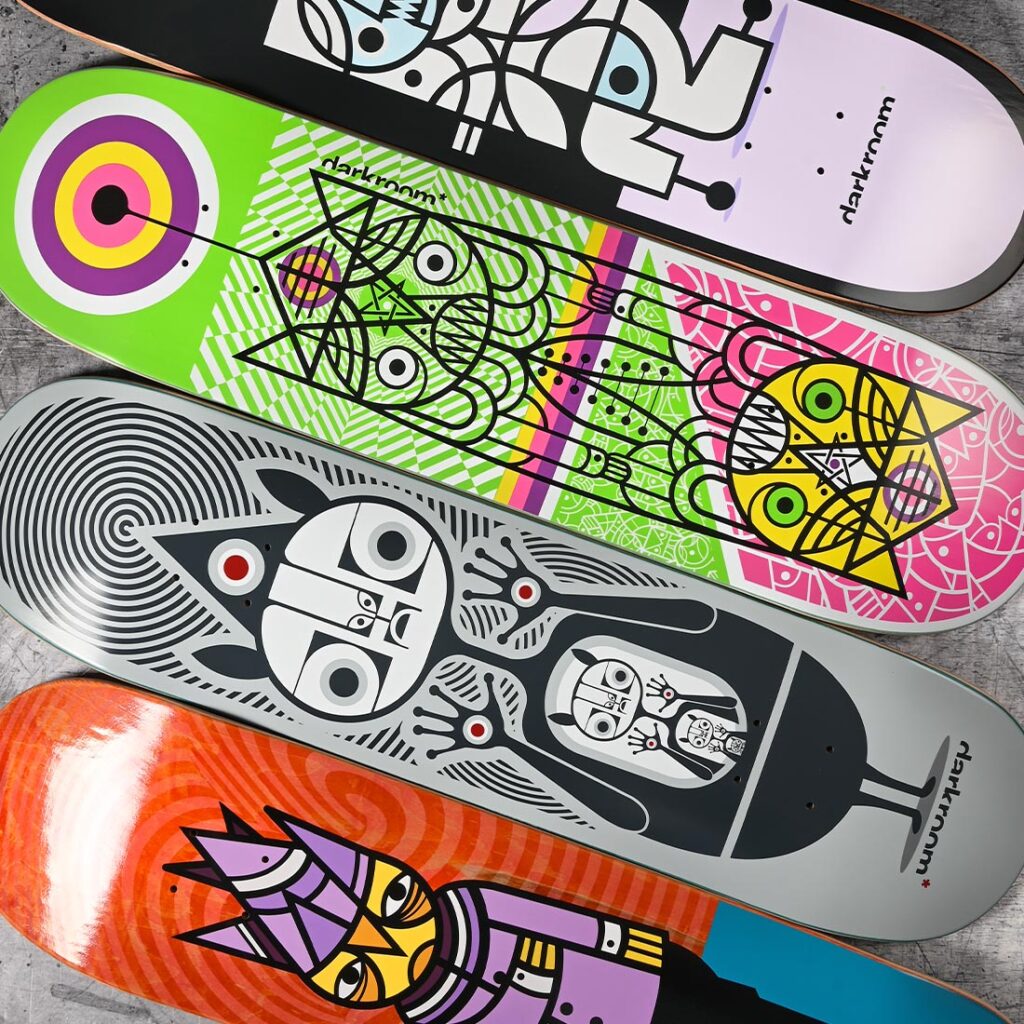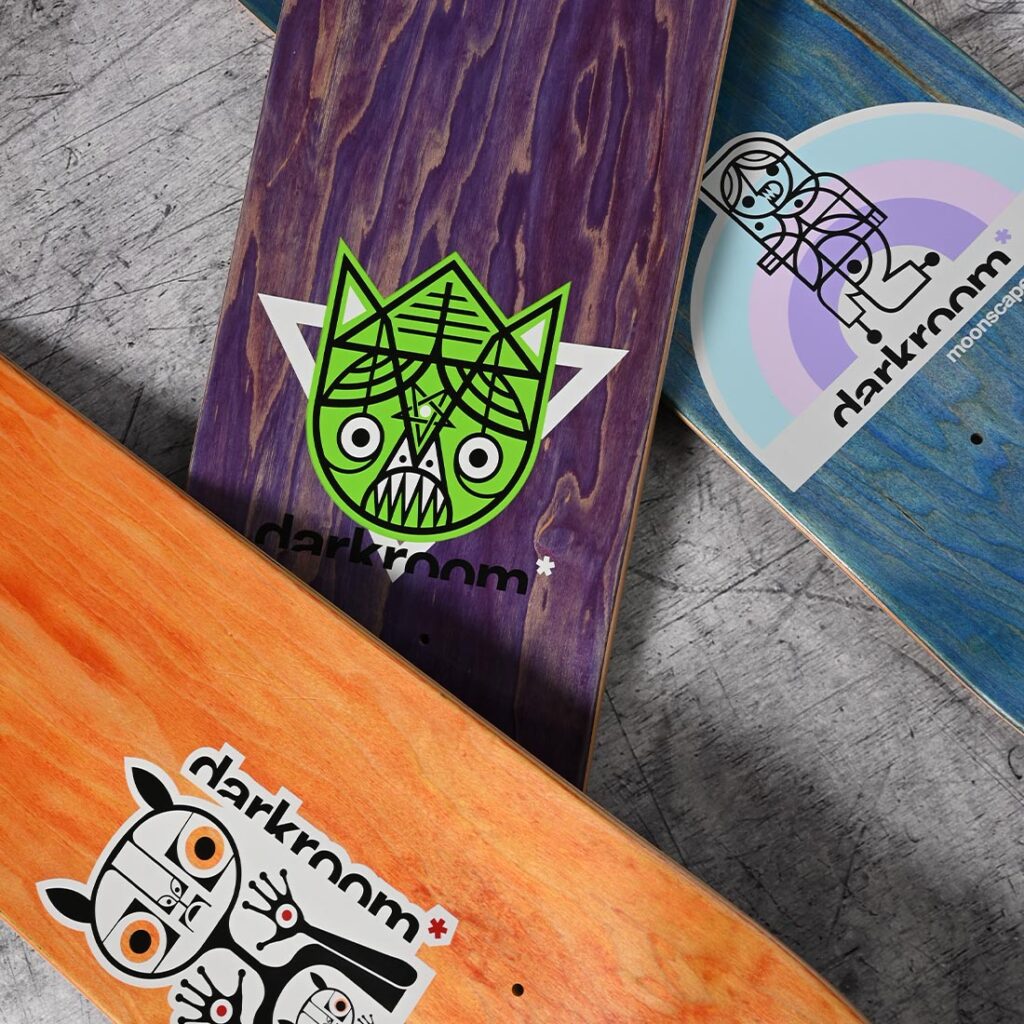Who is Don Pendleton?
Don Pendleton is unquestionably one of the most iconic artists in skateboarding. Starting his trade of skate specific art in 1998 for Alien Workshop up until 2005, Don created roughly 500 graphics for them over this time. These graphics are still idolised to this day, with a seriously passionate set of collectors and enthusiasts hunting for these rare pieces of art. These graphics encapsulate a very specific time in skateboarding, and anyone from that era will not only recognise Don’s art but also feel a very strong affinity towards it.
From 2005-2008, Don moved over to Element where he faced various issues and pushbacks with regards to his creative freedom which ultimately led him to create a personal project, Darkroom Skateboards. Darkroom was created to allow Don to rediscover his creative freedom and everything you see from Darkroom is an unfiltered piece of art directly from Dons sketchpad. We are so stoked to be able to have asked him some questions about the brand, his art direction, its new pros and everything in between.
Hi Don, thank you so much for taking the time to do this interview. You clearly have a strong bond with Middle America. What makes Ohio so special to you?
I’d say it’s because I’m acclimated to this whole area. It’s not far from where I grew up and I’m not super comfortable in larger cities. I don’t like traffic or crowds and I don’t have to deal with either of those where I live now. Dayton, OH is huge compared to the town I grew up in so I’ve got that going for me.
Favourite Elliott Smith song?
The thing about Elliott was that he could play really heavy music and also really soft, acoustic stuff so it’s tough to pick out a single song. I’ve heard all of the label released material so much that it would probably be a live version of one of the unreleased songs like ‘Mr. Good Morning.’ It’s kind of poppy and the exact opposite of the style that a lot of people try to pin on him. And for strictly acoustic stuff, Southern Belle.
Artistically, what are your favourite brands out at the moment?
I like FA and Hockey a lot still…I helped Dill with some of the early stuff and so I’ve been able to watch it grow and evolve and he’s done a great job with every aspect of both brands. I also like Welcome for the graphics and shapes and style. Real Skateboards for how they do everything. Heroin because I like how Fos isn’t afraid to put so much of himself into the brand and go all in with whatever he’s into. I think I’m more drawn to those brands that have survived and grown because that’s probably the real challenge…not just to do something cool but to build something that works and has some longevity while not getting too stale or just focusing on re-issuing old graphics. As far as newer companies, Strangelove for sure. Roger because I like Sieben and they have a great team and artwork. I like a lot more companies than I dislike these days, which is nice.
Working at Alien Workshop and Element
You have been so intrinsic to the branding of both Alien Workshop and Element over the years. With graphics being a huge driving force behind brand popularity, how do you feel about being one of the main selling points of these brands?
It’s just the nature of skateboarding and identity that your work becomes a part of the story a company creates if you’re doing graphics over a period of time. I felt like an important part of AWS so I’m proud of the art from that era but I think everyone was ready to move on by the time it ended. Carter and Hill took care of me, gave me the freedom to do what I wanted. Doesn’t get much better than that.
Has it ever been an issue leaving behind such an artistic legacy, to then create your own brand with a reminiscent style? It’s always been your artwork, but due to its affiliation to Workshop does it bother you that Darkroom may be directly compared?
Not at all…my art/style/concepts belong to me so it all follows me wherever I go…that’s always been the case so I’m used to it. I’ve been doing graphics for 23 years now and it’s been 16 years since I worked at AWS. I’m not a very nostalgic type of person…I feel like nostalgia is a response when someone feels like the past was better or more exciting than the present or future and I’ve not hit that point of my life yet, thankfully. I get that kids who grew up during that era romanticize the graphics from that time period and I’m stoked that people still like that stuff but looking at it all is kind of like hearing the same song over and over until you get to the point of indifference I guess.
Have you got any good stories from your time at Workshop or Element?
Let’s see…one time at AWS, Carter, Hill and myself were joking about how hot it was outside and Carter got the idea to get on the speaker and tell everyone who worked there to pull their cars inside of the warehouse or their car tires would melt. And everybody but 2 people did it. And we spent the rest of the day laughing about it.
At Element, one time I was out there for a sales meeting and there was a rumour that all of the employees were going to get iPods as a gift because the owner had been talking about a surprise for the employees. So everyone was stoked but the surprise ended up being breakdancers at the sales meeting.
Oh, and one time I set off the fire alarm at the Element headquarters by accident and the fire department had to come.
It sounds as though you had a lot of pushback and artistic differences at your time at Element, what was up with that? I saw you say something along the lines of you signed up to create original concepts but was effectively asked to rip off other brands’ t-shirt designs, which blew my mind.
I don’t spend too much time thinking about that period, to be honest. It was a situation that seemed to have potential and it ended up not being a match between myself and Element for artistic reasons. But I met a lot of great people over there and they had the budget to do things like art shows and exhibits. And there were breakdancers at the sales meetings.
Can you please tell me the story of the Rasta Anteater?
So Jeff Dickson was the hardgoods director at Element when I was there. Jeff is a super straightforward guy, a great dude. No nonsense but always had my back, kind of shielded me from the corporate garbage that came with a brand that big. I would send in graphics and they would get prodded and poked and changed by the owner, change the eyes, change the colors, make this bigger, etc. so I basically just quit sending over the stuff that I liked because I didn’t want it changed. Jeff always did what he could to keep that from happening but he couldn’t really challenge the owner of the company over issues like that.
I had sent in a graphic that didn’t get approved and sat on someone’s hard drive for like 6 months.
Anyway, one morning I wake up and get the mail and there is a CCS catalog in there and on the cover is this graphic I’d done but it had been changed…the layout, all the colors were changed to red and green and yellow and it had been made into a Tosh Townend pro model. So Tosh is on the cover of the catalog wearing his tam with the dreads hanging out and he’s holding this rasta-ized version of that anteater graphic.
I lost it (partly because I’d just woken up) and called Jeff to yell for a while (even though Jeff had nothing to do with it and didn’t know what was going on) and then I felt bad and apologized and accepted that whatever I did from that point forward had potential to be ruined and then publicly seen in a way that people would assume I did the final version. It was obvious that it was my art but presented in a way I would have never done it and it dawned on me that having someone else get final say over my art could really do some damage to me as an artist.
And that was kind of the beginning of the end as far as my interest in really putting a lot into what I was doing for them.
Influences and Covid-19
Has Covid influenced your graphics over the past 18 months? For example, some of your previous themes have been agoraphobia based, is this something you find yourself focusing on more at the moment?
I think Covid has influenced everything creatively for all artists for the past year to some degree. Everything was turned upside down for most people who make a living from art, personally and professionally. So that kind of thing creeps in but to be honest, I’m not a very social creature, I don’t go out for drinks or casually end up in social settings so most of what was weighing on me was how it affected others: teachers, retail workers, doctors and nurses. Those were the people I was worried about. Then that situation shined light on a specific demographic of Americans who probably never had much regard for science or medicine but they became very vocal about not understanding any of it, which compounded the problems in efforts to recover.
Ultimately that kind of ignorance coming to light probably weighed the heaviest. I mean, I knew those people existed in certain corners but they tended to be fairly quiet about it. We just happened to be living in a time when they all decided they wanted attention for it. In some circles, pride and ignorance finally collided and created a new kind of American monster.
And to be honest, I kind of preferred living in a country where I thought the anti-academic, anti-science, anti-intellectualism types were really far and few between.
So the answer to your question is that anything that heavy is going to creep into the creative process in some way or another. We had a graphic come out about a ‘virus’ in our first season and 2 graphics about plagues but they were done in September of 2019, long before Covid was on the radar. They happened to be released in early March when things were getting hectic worldwide but again, that was just a coincidence.
Talking about your artistic style specifically, as we have mentioned, you have a distinctive and instantly recognisable style. Is this something that you came to early on, or was it something that you developed and evolved over time?
I’ve said a lot in the past that it came from working at newspapers, which I did for several years prior to being at AWS…it wasn’t uncommon for me to have to create an illustration for a story and only have about 2 hours to do it. So I spent those years training myself to quickly draw ideas and concepts without too much attention to detail or specifics and those were the formative years in some ways. I hope that now my style is a combination of that kind of quick approach but it’s tempered with going back into the art to fix the details and lines where it’s not as sloppy as some of the work from my earlier years.
As you have got older, has the focus of your artwork changed? Has the message of your art found a new focus?
Not particularly…I think making art keeps people young in a lot of ways and I’ve done my best to not take any of it too seriously. My paintings are more personal than the graphics but I’m not the type to reveal too much in those either. Basically, I’m not that guy who takes his issues and stuffs them into his artwork with some kind of passive-aggressive manner. I think people expect that or look for it but I’m afraid I don’t have that many interesting issues going on. I hate spiders so that’s a theme that can creep in sometimes (and has a lot over the years) but I’m not really open to getting much more personal than that when it comes to skateboard graphics. Fear, anxiety, death, life, the unknown…those are all universal issues that everyone can relate to so those things might end up as part of a graphic here and there.


I can see the main priority in your professional art life is to maintain creative freedom, is this something you have transcended with Darkroom?
Absolutely. Sometimes that’s the main benefit to being part owner in a company. I can design products the way I want them to be seen and that’s the way they’re produced and end up on the market. And no matter what you do creatively (music, writing, art, etc.) the goal is to get it to an audience without it being edited/changed or diminished in some way. When you are in 100% control of the final product, you sleep much better at night for the most part. The upside: Nobody gets in the way of the creative process. The downside: There’s so much more that needs to be done than art for a brand and so it becomes a challenge to find enough time to dedicate to just doing the fun, creative stuff. In other words, people might imagine me sitting around a studio just doing graphics all day long but the truth is that I spend my days working on other parts of the brand that need time and attention and then I stay up until 6:00 am so I have time to just try to be creative and find the time to draw.
Running Darkroom and the new pros
With John Clemmons and Cotie Robinson just being announced as new Darkroom pros how much say did you have in making them pro?
That decision was made by myself and my business partner Kevin Furtado with input from our TM David Kappa. And it wasn’t really a business decision, it was more of a decision to try to help those guys out while we felt like we could, make a commitment to them and that kind of thing. That’s the cool part about owning a skateboard company is that you get to put the team together and you’re genuinely a fan of those guys’ skating…so I’m not a boss or a supervisor, I’m a fan of their skating and we want to see them go as far as they can with their passion and skill. It doesn’t feel very business-y, it just seemed like the next logical step for them and for us.
You are an advocate of Middle America, was this a deciding factor in getting John and Cotie on the team?
Maybe…not really consciously. I would have those guys on whether they were in Orange County or NYC or Chicago. They just happen to be in Kentucky and they’ve grown up skating together and that location has influenced their styles and their trick selection probably because of the spots they skate. So it has made them unique in a lot of ways but they would be great skaters anywhere. And I probably relate to them a lot more having grown up skating in West Virginia, which is close to Kentucky and has a similar culture, landscape and challenges. It’s not easy being a skater in a place where winters are gnarly and concrete isn’t always smooth. You adapt to everything and it becomes a part of how you skate in a lot of ways. The flip side of that is there are a lot of untapped spots and you learn creative ways to deal with it all.
How is it working with Mike Sinclair? It must be super helpful having someone so experienced helping with everything in the background.
Mike is awesome but he’s not involved in the company anymore. Basically, he just had too many other things going on with Tum Yeto and Nike and those had to come first. But we’re still tight and he still helps out whether he knows it or not. I talk to him regularly and similar to the John and Cotie situation, Mike grew up in North Carolina, I grew up in WV…we had a lot of really similar experiences with sponsors and skating outside of CA during that time period where everything happened out there. So we always related to one another really well because of that.
But yeah, nobody doesn’t like Mike and with good reason. He’s one of the really good dudes in skateboarding.
Neil Blender was a big inspiration for you, have you two ever met?
I did meet him back around 1989 (maybe? 1990?) My friend John Drake (who eventually was a pro for AWS) skated for G&S trucks at the time and the G&S TM was in Dayton, OH to film for their next video. So John and I drove to Dayton (from WV) and we stayed at Mark Heinzman’s house. Neil was living in the basement at the time so not only did I meet him there, I got to see him skate while he was filming for the video. Blender represented everything good about skateboarding at the time: Super good, creative skater, amazing artist, just seemed to think about everything outside of the box and that’s how skaters really distinguish themselves from the rest of the world: finding weird solutions to common problems. Alyasha Moore was living in Dayton at the time and I met him during that trip too. Alyasha is a creative genius who has done a lot of graphic work and design in skateboarding over the years.
Art and skateboarding
Do you think there is room in skating for artist backed brands? So many brands are regurgitating graphics with no real substance to them and looking back at the earlier graphics of skating it seems a shame to lose the truly artistic nature of these graphics.
Sure there’s room for it but there just seems to be much more of a demand for nostalgia and collaborations as far as sales go than there is for original artwork. Sean Cliver has done a great job with Strangelove but he’s a legend so that’s probably the exception rather than the rule. And he does it properly: screen printed boards with more limited runs. When I started skating, there were only about 40 pro models on the market so it was easy to get wrapped up and obsess over graphics. And they would be available for years rather than months. So the dynamics of how boards are sold, how saturated the market is and how quickly it all cycles that affects how skaters connect to all of that stuff. If you’re going to do an “art brand,” you’ll likely have a limited audience. Ideally, it’s all just ‘skateboard brands’ where the boards have interesting, unique and creative graphics.
What are your thoughts in general about skateboard graphics these days compared to, say, the 1980s? It seems we are in the era of Photoshop designs, with some companies mainly focused on logo boards now, whereas, back then graphics seemed much more hand-drawn and the process was more manual. How do you think the two styles compare?
There have always been trends within skateboarding and we’re just in that period now where I think FA set the pace for companies that don’t really have their own identity. So they saw the FA/Hockey aesthetic and felt like that’s what skaters want so they were going to do their own version of it. I think younger skaters used to be drawn to the more original and unique stuff and now they tend to want something they recognize (hence the slew of collage type graphics and corporate collaborations and logos). When you do something personal or unique, you take a risk and a lot of companies aren’t willing to take that risk and do their own thing beyond a certain point. To be honest, when I walk into a skate shop and look at the wall, I can’t really tell one brand from the other sometimes and I’m more drawn to the ones I recognize for their own style and art…whether it’s good or bad, it’s theirs and I’ve never understood the point of doing a skateboard company if it wasn’t to have a voice and use the graphics as a way to make some kind of different statement from the rest of the pack. But do younger skaters even care like I used to when I was their age? Probably not for the most part.
Creating designs and the artistic process
Do you mainly use Illustrator/Photoshop or is there an element of freehand drawing in creating your designs?
Everything starts out as a sketch in my sketchbook. That’s how I’ve always worked and really the only way I can stay productive just because the concepts all begin at that stage. Typically, I work out the kinks in the sketchbook with a pen or pencil and then I sit down to work it out in Illustrator. Mostly because all of my files are printed far away from Ohio and it’s super easy to email and prep digital files. I still do hand-drawn graphics (there were a few this past season) so it becomes a mix.
I never use photoshop. Only to mock things up or prepare a catalog but I’ve never really used photoshop as an art tool…maybe as a production tool when it’s necessary but I use it as little as possible.
We love your collaborations with other brands. When we saw your artwork on Pro-Tec helmets we instantly knew we had to get those in stock. Is there anything else in the works that we should be getting excited about?
I got to the point with Darkroom where I had to step away from doing freelance projects just because I didn’t have time for it. So I’ve turned down some projects that would have been interesting this past year…and that has taken some getting used to. But Darkroom fills my days (and nights) so there just isn’t time to do it all and I don’t want Darkroom to pay the price for me taking on more than I can handle with other clients. The pro-tec helmet was fun to work out so I’m stoked you like it, I think that was one of my final projects before I jumped all into Darkroom.
Thanks Don.

